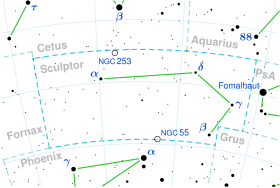Beta Sculptoris
| Observation data Epoch J2000 Equinox J2000 | |
|---|---|
| Constellation | Sculptor |
| Right ascension | 23h 32m 58.25898s[1] |
| Declination | −37° 49′ 05.7570″[1] |
| Apparent magnitude (V) | 4.37[2] |
| Characteristics | |
| Spectral type | B9.5IIIp(HgMnSi)[3] |
| U−B color index | −0.36[2] |
| B−V color index | −0.09[2] |
| Astrometry | |
| Radial velocity (Rv) | +0.4±0.6[4] km/s |
| Proper motion (μ) | RA: +95.97[1] mas/yr Dec.: +38.29[1] mas/yr |
| Parallax (π) | 18.74 ± 0.15 mas[1] |
| Distance | 174 ± 1 ly (53.4 ± 0.4 pc) |
| Absolute magnitude (MV) | 0.74[5] |
| Details | |
| Mass | 2.98[6] M☉ |
| Radius | 2.0[7] R☉ |
| Luminosity | 81[6] L☉ |
| Surface gravity (log g) | 4.28[7] cgs |
| Temperature | 12,110[6] K |
| Metallicity [Fe/H] | +0.15[5] dex |
| Rotational velocity (v sin i) | 26[6] km/s |
| Other designations | |
| Database references | |
| SIMBAD | data |
Beta Sculptoris, Latinized from β Sculptoris, is a single,[9] blue-white hued star in the southern constellation of Sculptor. It has an apparent visual magnitude of 4.37,[2] which is bright enough to be seen with the naked eye. Based upon an annual parallax shift of 18.74 mas as seen from Earth, it is located 174 light years from the Sun.
This is a B-type giant star with a stellar classification of B9.5IIIp(HgMnSi).[3] It belongs to the class of chemically peculiar stars known as a Mercury-Manganese star,[10] showing overabundances of mercury, manganese, and silicon in its spectrum. It is a suspected α2 CVn variable with magnitude variation from 4.35 to 4.39.[11] The star has nearly three[6] times the mass of the Sun and double[7] the Sun's radius. It is radiating 81[6] times the Sun's luminosity from its photosphere at an effective temperature of 12,110 K.[6]
References
- ^ a b c d e Van Leeuwen, F. (2007). "Validation of the new Hipparcos reduction". Astronomy and Astrophysics. 474 (2): 653. arXiv:0708.1752. Bibcode:2007A&A...474..653V. doi:10.1051/0004-6361:20078357. Vizier catalog entry
- ^ a b c d Ducati, J. R. (2002). "VizieR Online Data Catalog: Catalogue of Stellar Photometry in Johnson's 11-color system". CDS/ADC Collection of Electronic Catalogues. 2237. Bibcode:2002yCat.2237....0D.
- ^ a b Abt, Helmut A.; Morrell, Nidia I. (1995). "The Relation between Rotational Velocities and Spectral Peculiarities among A-Type Stars". Astrophysical Journal Supplement. 99: 135. Bibcode:1995ApJS...99..135A. doi:10.1086/192182.
- ^ Gontcharov, G. A. (2006). "Pulkovo Compilation of Radial Velocities for 35 495 Hipparcos stars in a common system". Astronomy Letters. 32 (11): 759. arXiv:1606.08053. Bibcode:2006AstL...32..759G. doi:10.1134/S1063773706110065.
- ^ a b Anderson, E.; Francis, Ch. (2012). "XHIP: An extended hipparcos compilation". Astronomy Letters. 38 (5): 331. arXiv:1108.4971. Bibcode:2012AstL...38..331A. doi:10.1134/S1063773712050015. Vizier catalog entry
- ^ a b c d e f g Zorec, J.; Royer, F. (2012). "Rotational velocities of A-type stars". Astronomy & Astrophysics. 537: A120. arXiv:1201.2052. Bibcode:2012A&A...537A.120Z. doi:10.1051/0004-6361/201117691. Vizier catalog entry
- ^ a b c Allende Prieto, C.; Lambert, D. L. (1999). "Fundamental parameters of nearby stars from the comparison with evolutionary calculations: Masses, radii and effective temperatures". Astronomy and Astrophysics. 352: 555. arXiv:astro-ph/9911002. Bibcode:1999A&A...352..555A. Vizier catalog entry
- ^ "bet Scl". SIMBAD. Centre de données astronomiques de Strasbourg. Retrieved 2017-11-28.
{{cite web}}: CS1 maint: postscript (link) - ^ Chini, R.; et al. (2012), "A spectroscopic survey on the multiplicity of high-mass stars", Monthly Notices of the Royal Astronomical Society, 424 (3): 1925, arXiv:1205.5238, Bibcode:2012MNRAS.424.1925C, doi:10.1111/j.1365-2966.2012.21317.x.
{{citation}}: CS1 maint: unflagged free DOI (link) - ^ Makaganiuk, V.; et al. (January 2011), "The search for magnetic fields in mercury-manganese stars", Astronomy and Astrophysics, 525: A97, arXiv:1010.3931, Bibcode:2011A&A...525A..97M, doi:10.1051/0004-6361/201015666.
- ^ Watson, C. L. (2006). "The International Variable Star Index (VSX)". The Society for Astronomical Sciences 25th Annual Symposium on Telescope Science. Held May 23–25. 25: 47. Bibcode:2006SASS...25...47W.

